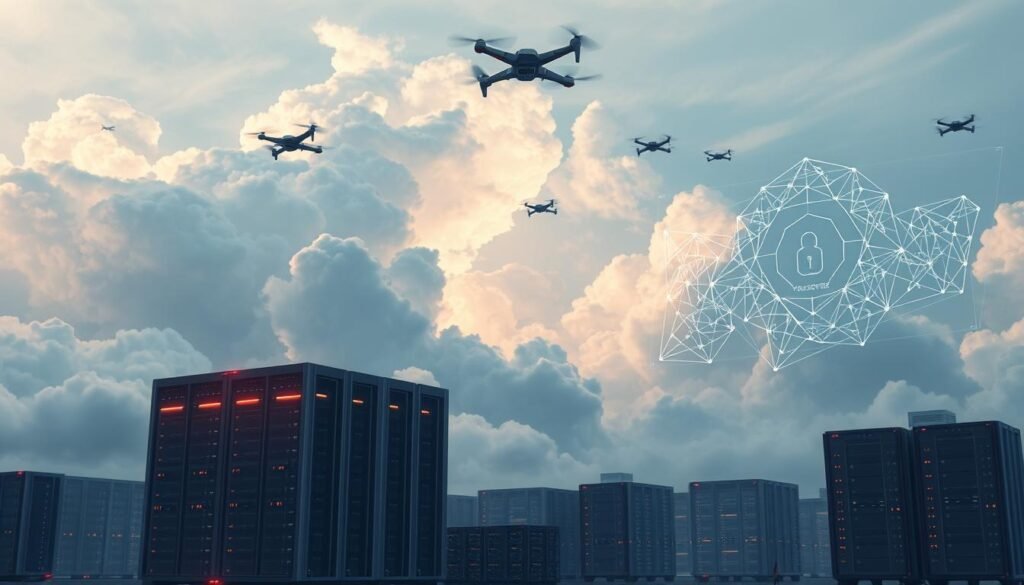Did you know the global security market is set to explode from $172 billion to over $560 billion by 2032? With threats growing faster than defenses, businesses face a critical question: How can they stay ahead in this high-stakes race?
North America leads the charge, holding nearly 44% of the market. The U.S. alone could hit $166 billion in security spending within a decade. Rising cloud adoption and AI-driven solutions fuel this boom, but talent shortages and complex threats create roadblocks.
Industries like finance, healthcare, and manufacturing now prioritize data protection. Regulatory pressures add urgency, pushing companies to invest in advanced services. The challenge? Balancing rapid technology growth with evolving risks.
Key Takeaways
- The security market will triple in value by 2032.
- North America dominates global investments.
- AI and cloud solutions drive major growth.
- 92% of organizations struggle to find skilled talent.
- Regulations force faster adoption of protective measures.
Global Cybersecurity Market Overview
The digital security landscape has undergone massive shifts in recent years. Enterprises now grapple with a 37% surge in ransomware attacks since 2020, fueled by rapid cloud adoption and remote work. The global market reflects this urgency, with projections hinting at exponential growth.
Market Size and Growth Projections
Cloud-based solutions dominate, holding 58% of the market share. Managed services are growing fastest, as businesses outsource complex data protection needs. By 2032, spending could triple, driven by AI and regulatory pressures.
Smaller firms face higher risks. 68% of SMEs reported phishing attacks post-COVID, with 43% temporarily closing. Larger enterprises adapt faster, but gaps remain. A Texas steel manufacturer’s bankruptcy highlighted the stakes.
Impact of COVID-19 on Security Demand
The pandemic accelerated cloud migration, creating new attack surfaces. Governments responded—the EU invested $2.3 billion in UK defenses in 2020. Today, hybrid work models keep demand for security solutions high.
Budgets strain SMEs, but growth rates suggest recovery. The key? Balancing innovation with resilience as threats evolve yearly.
Key Trends Shaping the Cybersecurity Sector
Businesses are racing to adopt new technologies as threats evolve at lightning speed. From AI-driven detection to zero-trust frameworks, innovations are reshaping how organizations protect critical data. These advancements aren’t optional—they’re essential for survival in a high-risk digital world.

Integration of AI, IoT, and Cloud Technologies
Over 80% of enterprises now rely on multi-cloud environments, blending solutions like Microsoft Azure and AWS. Cisco’s $28 billion Splunk acquisition highlights the demand for cloud-based analytics. These tools detect threats faster, reducing response times by 60%.
IBM’s Analytics-as-a-Service platform uses AI to predict breaches before they happen. Such technology is critical as IoT devices multiply, creating new entry points for attacks.
Rising Importance of Data Privacy
GDPR fines—up to 4% of revenue—force companies to prioritize protection. Microsoft’s confidential computing now encrypts data even during processing. Consumers also demand transparency, with 73% abandoning brands after breaches.
Zero-Trust Architecture Adoption
Zero-trust adoption surged 320% since 2020, per NIST guidelines. Partnerships like Darktrace and Xage combine AI with zero-trust frameworks. This approach verifies every access request, slashing insider threats by 45%.
Federal agencies lead this shift, but SMEs are catching up. The message is clear: trust nothing, verify everything.
Major Challenges in Cybersecurity
Organizations face mounting hurdles as digital threats outpace defenses. While global security spending hits $150 billion, cybercrime costs could reach $10.5 trillion by 2025. This gap highlights critical pain points—from talent shortages to budget wars.
Talent Shortages and Skill Gaps
The U.S. alone has 600,000 unfilled security jobs. Enterprises compete fiercely for skilled professionals, yet 92% of organizations report hiring difficulties. Smaller firms suffer most, often losing talent to corporate giants offering higher pay.
Budget Constraints for SMEs
Small businesses spend just one-fifth of what large enterprises allocate for protection. A midmarket company might pay $500,000 annually for an in-house SOC team—versus $150,000 for managed services. Yet, 43% of SMEs hit by attacks face temporary closures.
Increasing Sophistication of Cyberattacks
Forty percent of 2021 malware variants were zero-day exploits. The Colonial Pipeline attack—triggered by a single compromised password—cost $4.4 million in ransom and halted fuel deliveries. Even outdated software, like unpatched systems vulnerable to EternalBlue, remains a glaring risk.
Defense contractors now grapple with CMMC compliance costs exceeding $100,000. As attacks grow smarter, businesses must weigh innovation against resilience.
Emerging Opportunities in Cybersecurity
The security landscape isn’t just evolving—it’s creating massive opportunities for innovation. Companies leveraging managed services, cloud-based solutions, and compliance tools are gaining a competitive edge. With threats multiplying, these areas offer both protection and profit potential.

Growth in Managed Security Services
The MSSP market is booming at an 18% CAGR, driven by talent shortages and cost efficiency. Palo Alto’s Cortex XDR platform, for example, automates threat detection, reducing response times by 70%. Small businesses now outsource 60% of their security needs to MSSPs.
Check Point’s Harmony SaaS saw 200% adoption growth in 2023, proving demand for scalable services. Enterprises save up to 40% compared to in-house teams, making MSSPs a smart recovery strategy post-breach.
Expansion of Cloud-Based Solutions
Hybrid cloud solutions dominate, with 78% of enterprises using them. AWS GuardDuty and Azure Sentinel lead the segment, offering AI-driven monitoring at competitive prices. Liquid C2’s African market expansion with Google Cloud highlights global adoption.
Cloud-first strategies cut costs by 30% while improving scalability. The key? Integrating zero-trust frameworks into cloud architectures for airtight security.
Regulatory Compliance Driving Demand
CCPA created a $2.4 billion compliance services market in California alone. HIPAA costs for healthcare providers average $80,000 annually, but penalties for non-compliance reach millions. Automated software like IBM’s RegTech simplifies audits.
Global regulations will push 65% of firms to upgrade protections by 2025. Investing now ensures growth without legal backlash.
Cybersecurity Market Segmentation
Market segmentation reveals critical patterns in how businesses defend against digital threats. Companies invest differently based on needs, risks, and regulations. Three key divisions—components, deployment models, and industries—shape spending trends.
By Component: Solutions vs. Services
Identity and access management (IAM) solutions dominate 28% of this segment. Tools like SIEM cost 40% less to implement than SOAR platforms but require more manual oversight. Enterprises often blend both for full coverage.
Managed services fill talent gaps, especially for SMEs. Partnerships like Zscaler and TitanHQ offer web filtering as a service, reducing costs by 35%. Demand for these services grows 18% yearly.
By Deployment: Cloud vs. On-Premises
Cloud deployments save 30% over five years versus on-premises setups. Hybrid models lead, with AWS GuardDuty detecting threats 60% faster than legacy systems. Financial firms still prefer on-prem for sensitive data due to SWIFT CSP requirements.
Total cost of ownership (TCO) analysis shows cloud wins long-term. Scaling is cheaper, and updates are automatic. However, industries like healthcare face compliance hurdles when migrating.
By Industry: BFSI, Healthcare, and IT
Banks and insurers drive 34% of industry revenue. The 2023 HHS report notes healthcare breaches rose 19%, pushing CAGR to match. IT firms adopt AI tools fastest, cutting response times by half.
Data protection laws vary by sector. HIPAA penalties force healthcare upgrades, while PCI DSS shapes finance. Each industry’s unique risks demand tailored solutions.
Regional Insights: North America Leads the Market
Regional spending patterns reveal stark contrasts in security investments worldwide. North America commands 44% of global market volume, with the U.S. driving 62% of regional activity. This dominance stems from aggressive private-sector adoption and federal initiatives like CISA’s Shields Up program.
U.S. Cybersecurity Market Dynamics
The U.S. market thrives on cross-industry collaboration between companies and agencies. CISA’s 2022 Shields Up initiative mobilized $2 billion in critical infrastructure protection funding. Private firms now account for 78% of advanced solution purchases.
Financial services lead sector spending at $34 billion annually. Healthcare follows closely, with 90% of hospitals upgrading systems after recent breaches. This creates a $166 billion opportunity by 2032.
Europe and Asia-Pacific Growth Potential
Europe’s €2 billion Cybersecurity Act fund accelerates compliance with GDPR standards. Enforcement fines now average 2.5% of revenue versus California’s 1% under CCPA. Germany and France account for 60% of regional investments.
Asia-Pacific shows the fastest growth at 18% CAGR. Singapore’s 2026 strategy allocates $500 million for AI-driven solutions. India’s spending jumped 87% since 2020, while Japan protects critical infrastructure with $300 million annually.
Middle Eastern smart cities now dedicate 15% of IT budgets to security. These regional trends highlight evolving priorities in global risk management.
Key Players and Competitive Landscape
The race to dominate digital protection has sparked fierce competition among industry leaders. Giants like Cisco, IBM, and Palo Alto Networks are reshaping defenses with cutting-edge solutions and bold strategies. Their moves set the pace for smaller firms scrambling to keep up.
Innovations Driving Market Leadership
Cisco made waves with its $28 billion Splunk acquisition, merging network and data analytics. This creates an AI-powered threat detection system that processes 100 billion events daily. IBM secured a $650 million NATO contract, deploying quantum-resistant encryption across 30 nations.
Palo Alto Networks leads with Cortex XDR, reducing breach detection time to 10 minutes. Fortinet’s Security Fabric architecture now protects 500,000+ devices globally. These key players invest heavily in R&D, with budgets exceeding $2 billion annually.
Alliances Reshaping the Industry
Strategic partnerships now drive 80% of revenue for top MSSPs. Microsoft’s Secure Score adoption jumped 240% as firms seek unified protection. CrowdStrike and SentinelOne battle for EDR dominance, with detection rates above 99%.
Verizon’s DBIR report reveals finance and healthcare as top attack targets. Mandiant’s FireEye rebrand focuses on threat intelligence services. Such moves highlight how business models evolve to meet escalating risks.
The competitive landscape favors those blending AI, automation, and human expertise. As threats multiply, collaboration between key players becomes essential for survival.
Conclusion
The future of digital protection hinges on rapid innovation and smart investments. With a projected 14.3% CAGR through 2032, the market offers immense growth potential, especially in cloud, AI, and zero-trust solutions.
Small businesses can leverage managed security services (MSSPs) to bridge talent gaps. Public-private partnerships will be critical for sharing threat intelligence and scaling defenses.
As organizations navigate this evolving landscape, adopting advanced technology isn’t optional—it’s essential for survival. The next decade will reward those who act now to secure their digital futures.
FAQ
How big is the global security services market?
The market is projected to exceed 0 billion by 2028, growing at a CAGR of over 10%. Demand is driven by rising threats and digital transformation.
How did COVID-19 affect security needs?
Remote work increased vulnerabilities, pushing companies to invest in cloud-based protection and endpoint solutions. Attacks like phishing surged by 600% in 2020.
Why is zero-trust gaining traction?
Traditional perimeter defenses fail against advanced threats. Zero-trust enforces strict access controls, reducing risks for hybrid work environments.
What industries face the highest risks?
BFSI, healthcare, and IT are prime targets due to sensitive data. Ransomware attacks on hospitals rose by 123% in recent years.
Which regions lead in security spending?
North America holds 40% market share, but Asia-Pacific is fastest-growing, with China and India boosting investments.
How do small businesses handle budget limits?
Many adopt managed services or freemium tools like CrowdStrike. Government grants also help SMEs strengthen defenses.
What role does AI play in threat detection?
AI analyzes behavioral patterns to spot anomalies. IBM’s Watson catches 85% more breaches than traditional methods.
Who are the top providers in this space?
Leaders include Palo Alto Networks (firewalls), Cisco (network security), and Microsoft (cloud solutions). Acquisitions like Splunk by Cisco fuel innovation.






